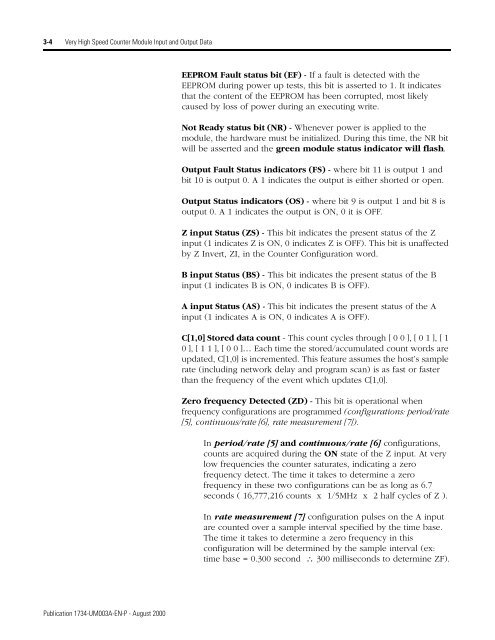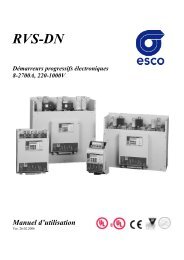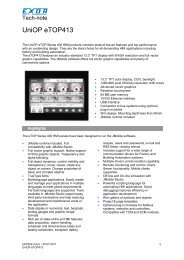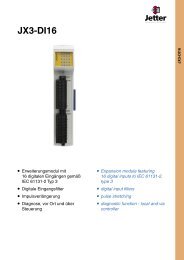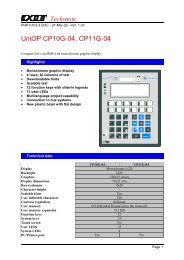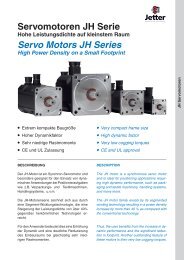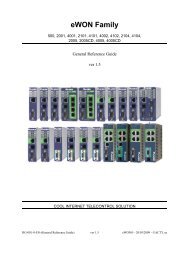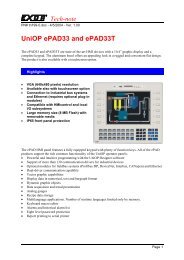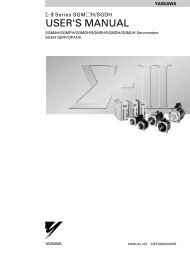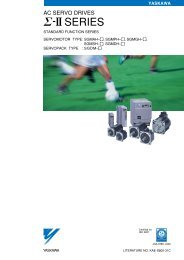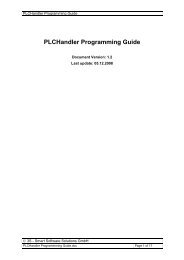Very High Speed Counter Module - Esco Drives & Automation
Very High Speed Counter Module - Esco Drives & Automation
Very High Speed Counter Module - Esco Drives & Automation
Create successful ePaper yourself
Turn your PDF publications into a flip-book with our unique Google optimized e-Paper software.
3-4 <strong>Very</strong> <strong>High</strong> <strong>Speed</strong> <strong>Counter</strong> <strong>Module</strong> Input and Output Data<br />
EEPROM Fault status bit (EF) - If a fault is detected with the<br />
EEPROM during power up tests, this bit is asserted to 1. It indicates<br />
that the content of the EEPROM has been corrupted, most likely<br />
caused by loss of power during an executing write.<br />
Not Ready status bit (NR) - Whenever power is applied to the<br />
module, the hardware must be initialized. During this time, the NR bit<br />
will be asserted and the green module status indicator will flash.<br />
Output Fault Status indicators (FS) - where bit 11 is output 1 and<br />
bit 10 is output 0. A 1 indicates the output is either shorted or open.<br />
Output Status indicators (OS) - where bit 9 is output 1 and bit 8 is<br />
output 0. A 1 indicates the output is ON, 0 it is OFF.<br />
Z input Status (ZS) - This bit indicates the present status of the Z<br />
input (1 indicates Z is ON, 0 indicates Z is OFF). This bit is unaffected<br />
by Z Invert, ZI, in the <strong>Counter</strong> Configuration word.<br />
B input Status (BS) - This bit indicates the present status of the B<br />
input (1 indicates B is ON, 0 indicates B is OFF).<br />
A input Status (AS) - This bit indicates the present status of the A<br />
input (1 indicates A is ON, 0 indicates A is OFF).<br />
C[1,0] Stored data count - This count cycles through [ 0 0 ], [ 0 1 ], [ 1<br />
0 ], [ 1 1 ], [ 0 0 ]… Each time the stored/accumulated count words are<br />
updated, C[1,0] is incremented. This feature assumes the host’s sample<br />
rate (including network delay and program scan) is as fast or faster<br />
than the frequency of the event which updates C[1,0].<br />
Zero frequency Detected (ZD) - This bit is operational when<br />
frequency configurations are programmed (configurations: period/rate<br />
[5], continuous/rate [6], rate measurement [7]).<br />
In period/rate [5] and continuous/rate [6] configurations,<br />
counts are acquired during the ON state of the Z input. At very<br />
low frequencies the counter saturates, indicating a zero<br />
frequency detect. The time it takes to determine a zero<br />
frequency in these two configurations can be as long as 6.7<br />
seconds ( 16,777,216 counts x 1/5MHz x 2 half cycles of Z ).<br />
In rate measurement [7] configuration pulses on the A input<br />
are counted over a sample interval specified by the time base.<br />
The time it takes to determine a zero frequency in this<br />
configuration will be determined by the sample interval (ex:<br />
time base = 0.300 second ∴ 300 milliseconds to determine ZF).<br />
Publication 1734-UM003A-EN-P - August 2000


